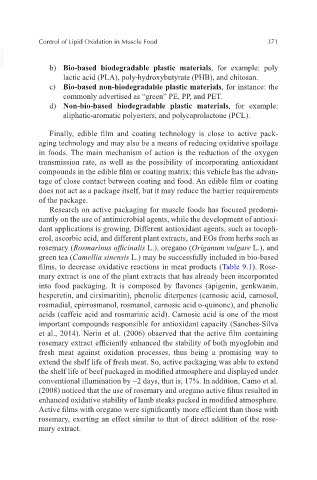Page 392 - Natural Antioxidants, Applications in Foods of Animal Origin
P. 392
Control of Lipid Oxidation in Muscle Food 371
VetBooks.ir b) Bio-based biodegradable plastic materials, for example: poly
lactic acid (PLA), poly hydroxybutyrate (PHB), and chitosan.
c) Bio-based non-biodegradable plastic materials, for instance: the
commonly advertised as “green” PE, PP, and PET.
d) Non-bio-based biodegradable plastic materials, for example:
aliphatic-aromatic polyesters, and polycaprolactone (PCL).
Finally, edible film and coating technology is close to active pack-
aging technology and may also be a means of reducing oxidative spoilage
in foods. The main mechanism of action is the reduction of the oxygen
transmission rate, as well as the possibility of incorporating antioxidant
compounds in the edible film or coating matrix; this vehicle has the advan-
tage of close contact between coating and food. An edible film or coating
does not act as a package itself, but it may reduce the barrier requirements
of the package.
Research on active packaging for muscle foods has focused predomi-
nantly on the use of antimicrobial agents, while the development of antioxi-
dant applications is growing. Different antioxidant agents, such as tocoph-
erol, ascorbic acid, and different plant extracts, and EOs from herbs such as
rosemary (Rosmarinus officinalis L.), oregano (Origanum vulgare L.), and
green tea (Camellia sinensis L.) may be successfully included in bio-based
films, to decrease oxidative reactions in meat products (Table 9.1). Rose-
mary extract is one of the plant extracts that has already been incorporated
into food packaging. It is composed by flavones (apigenin, genkwanin,
hesperetin, and cirsimaritin), phenolic diterpenes (carnosic acid, carnosol,
rosmadial, epirrosmanol, rosmanol, carnosic acid o-quinone), and phenolic
acids (caffeic acid and rosmarinic acid). Carnosic acid is one of the most
important compounds responsible for antioxidant capacity (Sanches-Silva
et al., 2014). Nerin et al. (2006) observed that the active film containing
rosemary extract efficiently enhanced the stability of both myoglobin and
fresh meat against oxidation processes, thus being a promising way to
extend the shelf life of fresh meat. So, active packaging was able to extend
the shelf life of beef packaged in modified atmosphere and displayed under
conventional illumination by ~2 days, that is, 17%. In addition, Camo et al.
(2008) noticed that the use of rosemary and oregano active films resulted in
enhanced oxidative stability of lamb steaks packed in modified atmosphere.
Active films with oregano were significantly more efficient than those with
rosemary, exerting an effect similar to that of direct addition of the rose-
mary extract.

